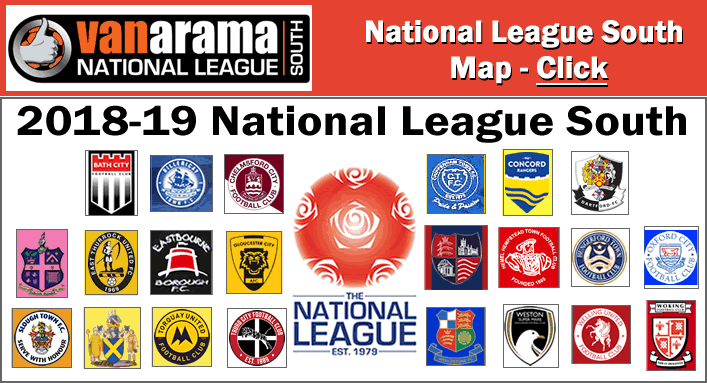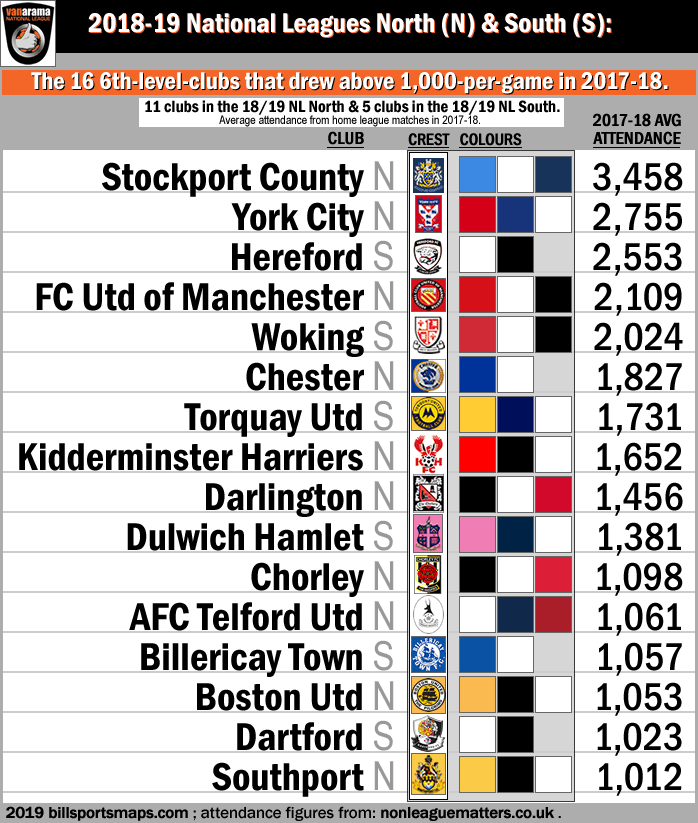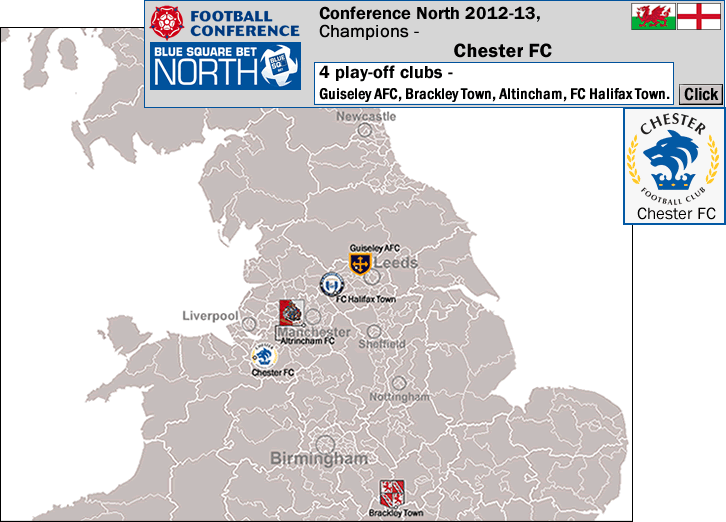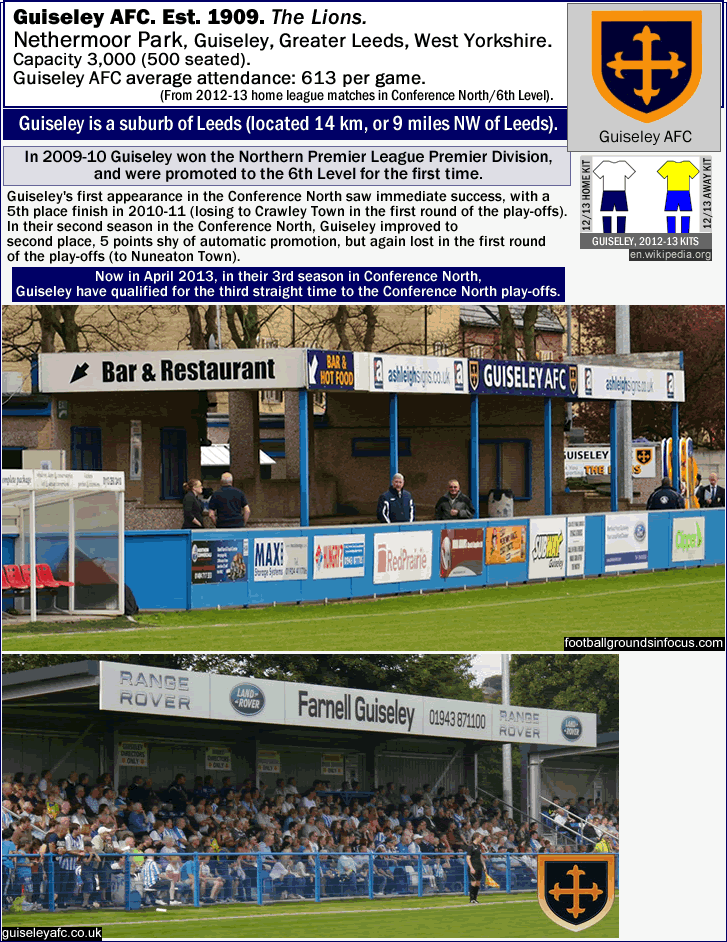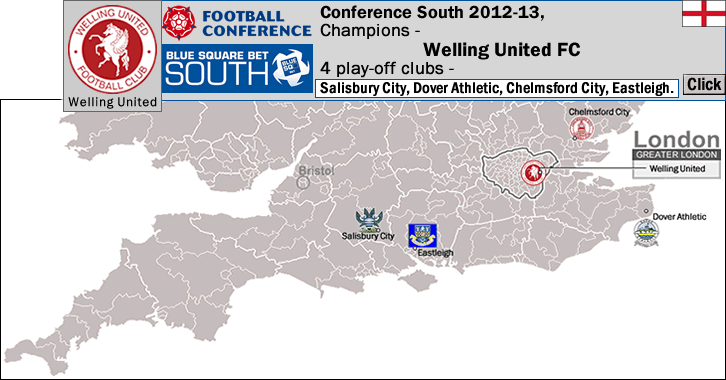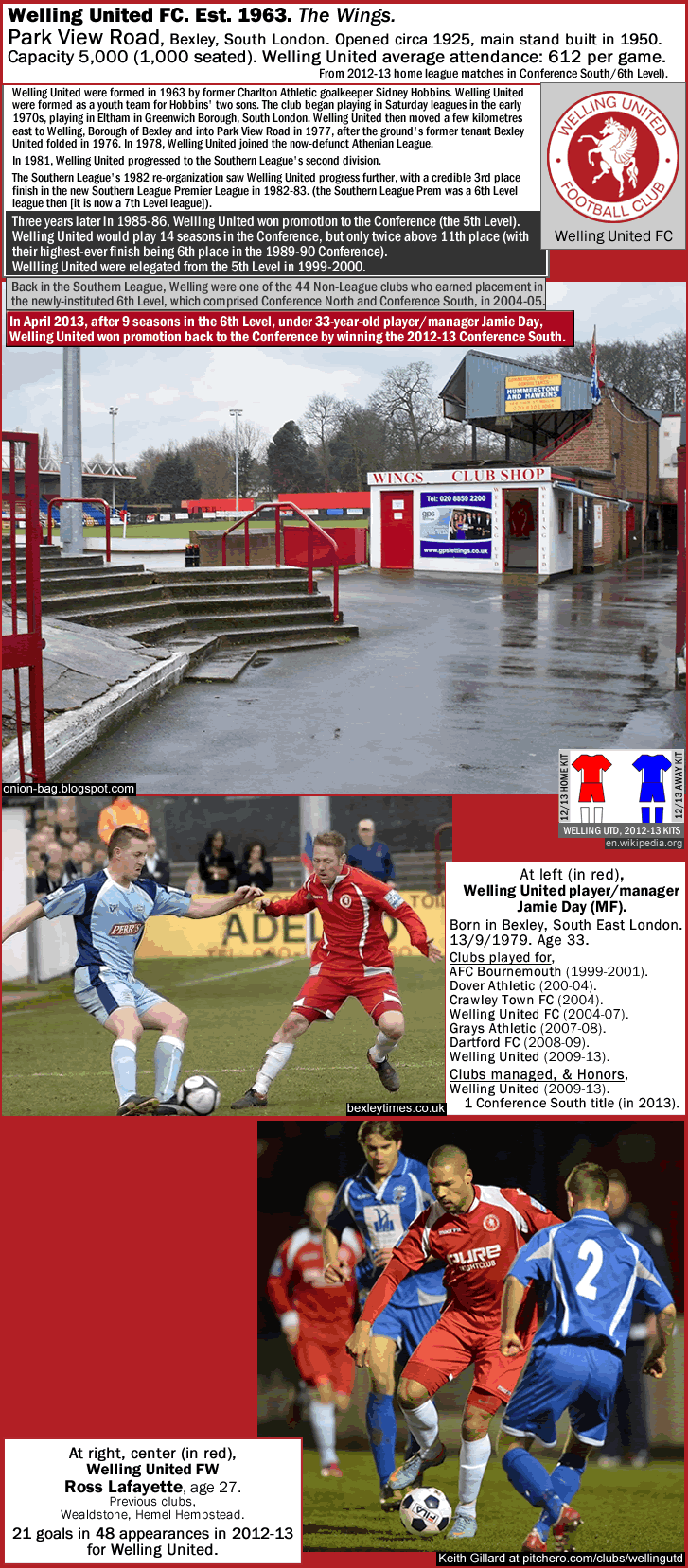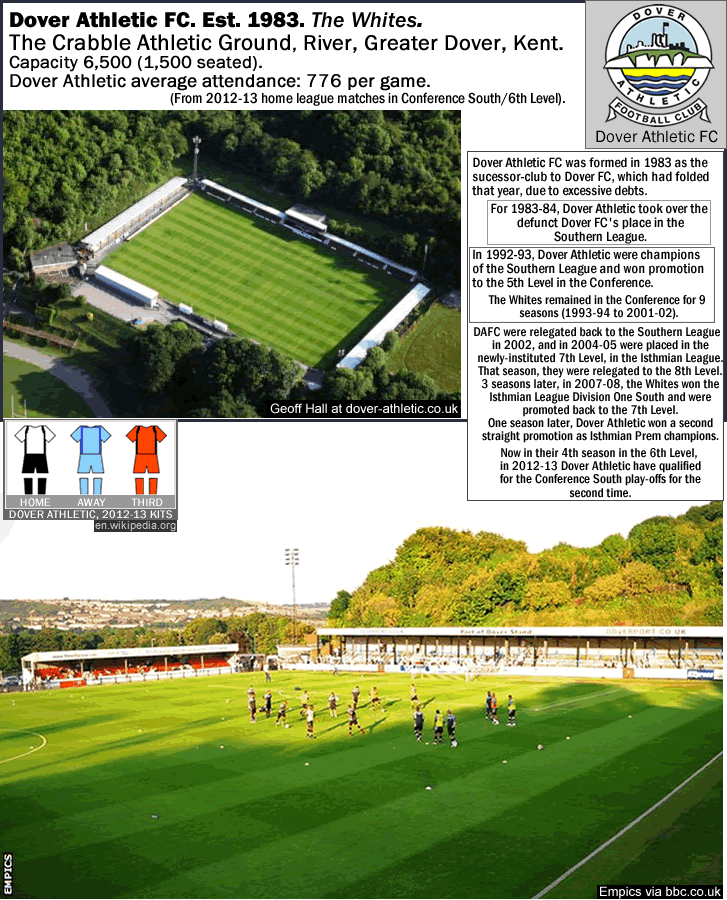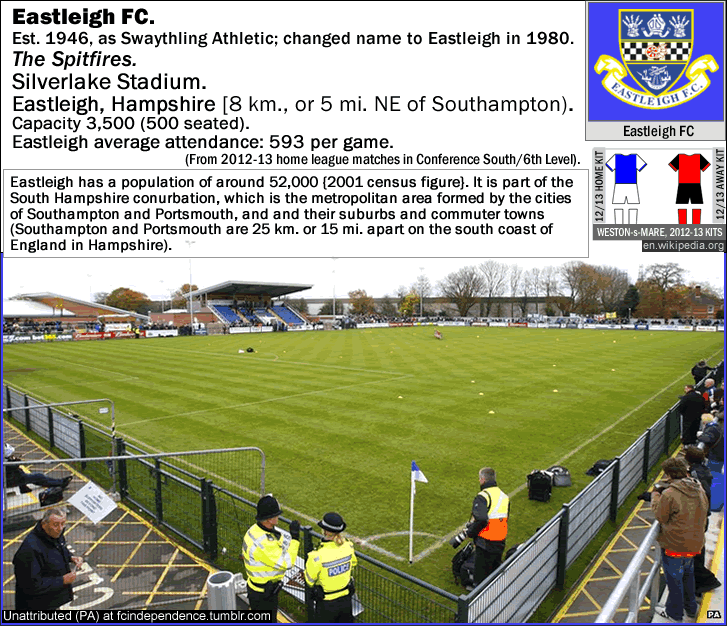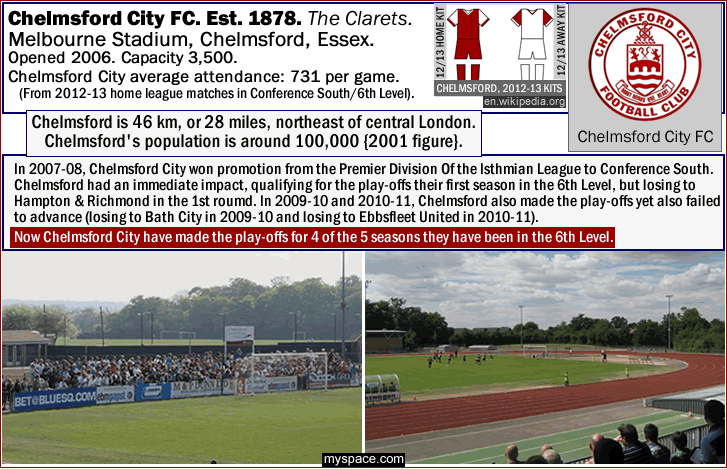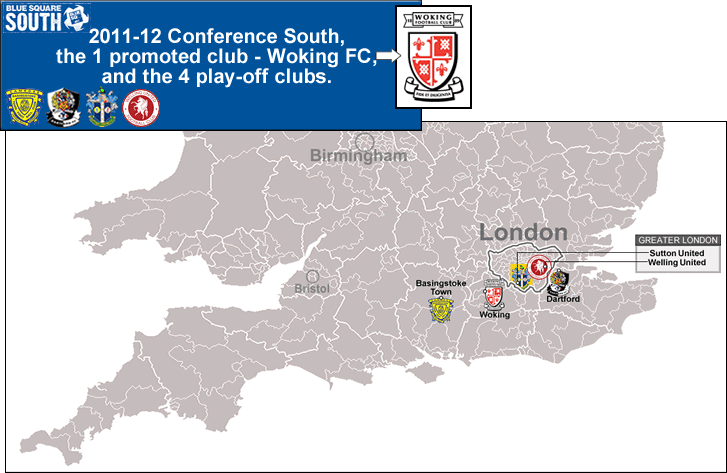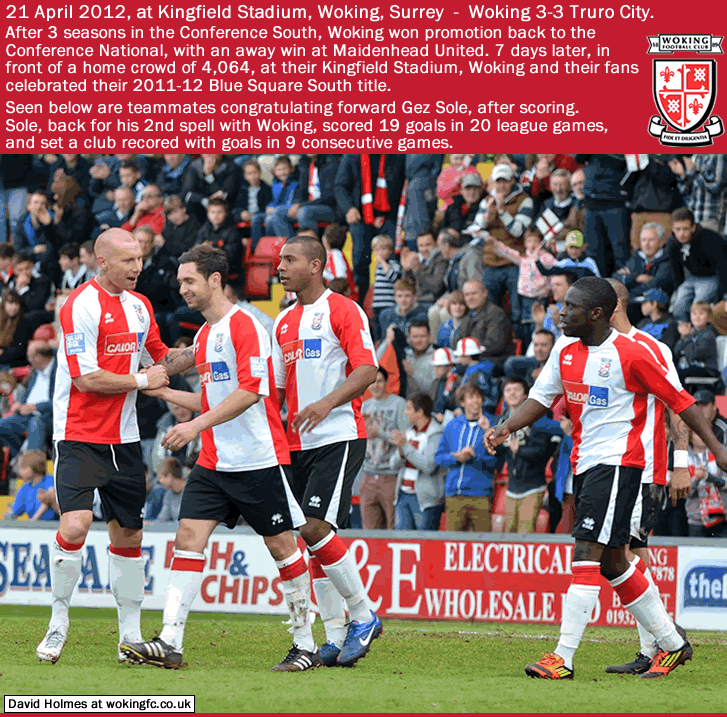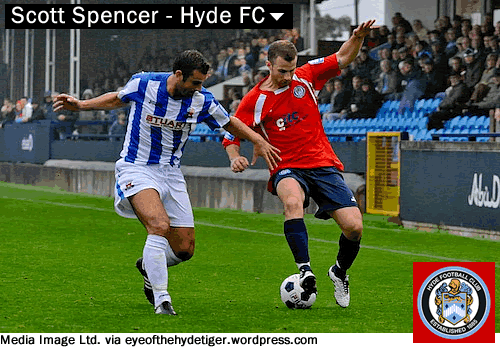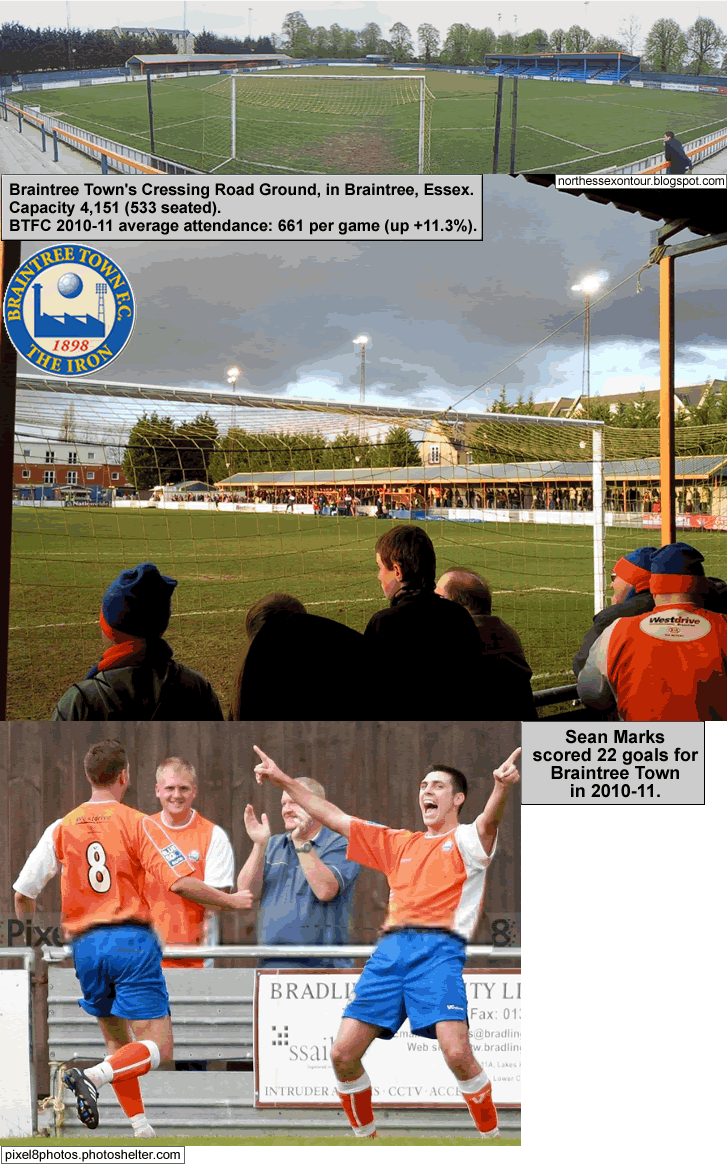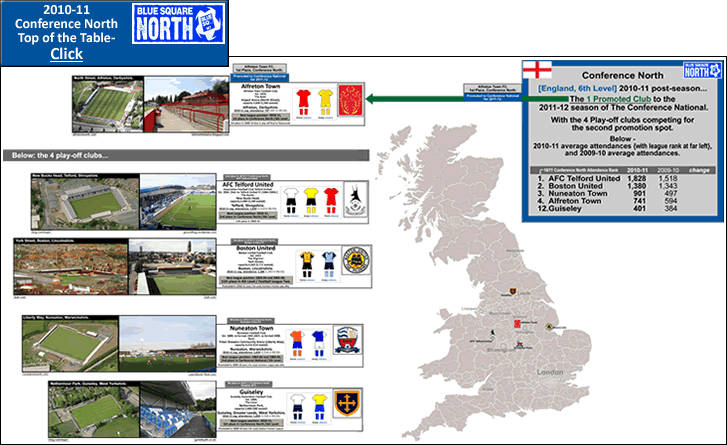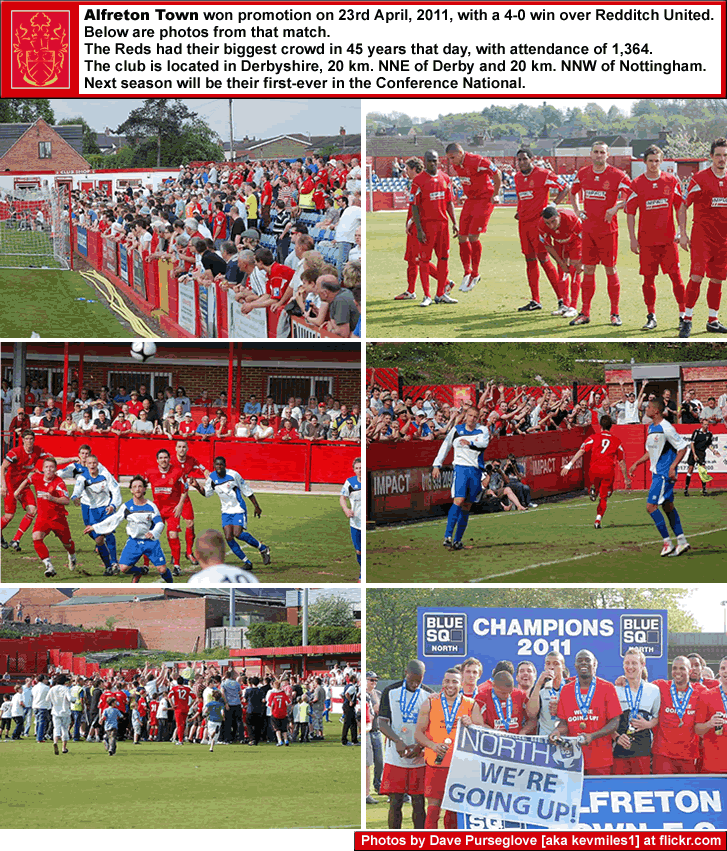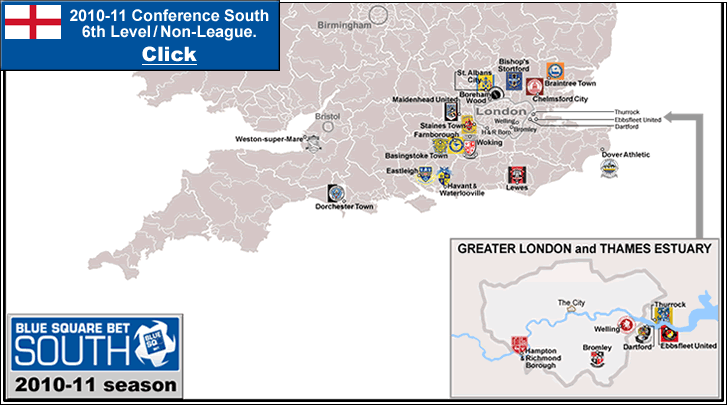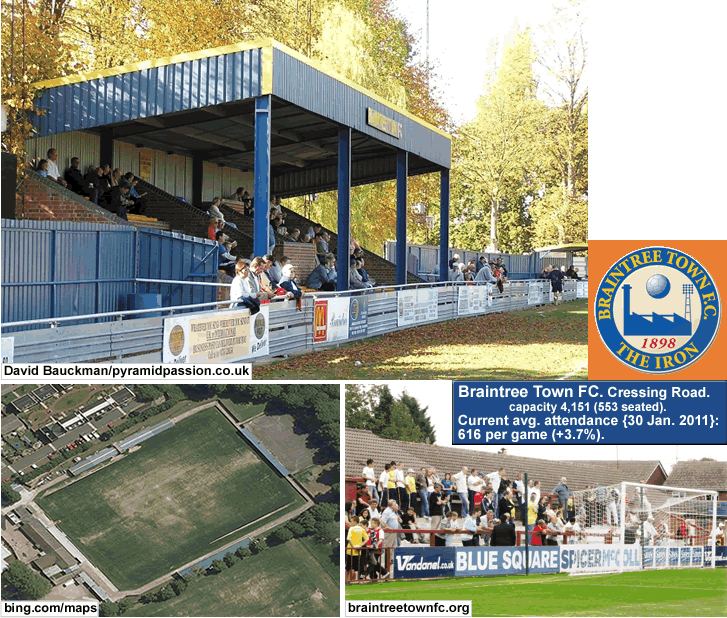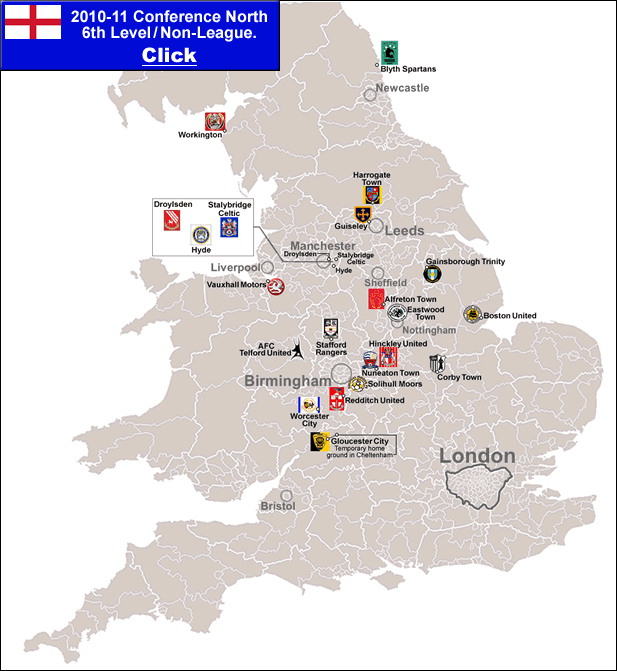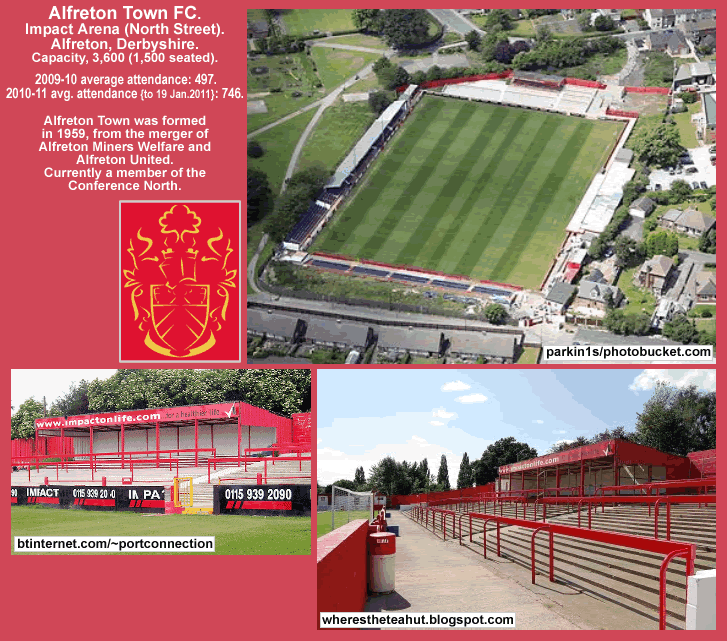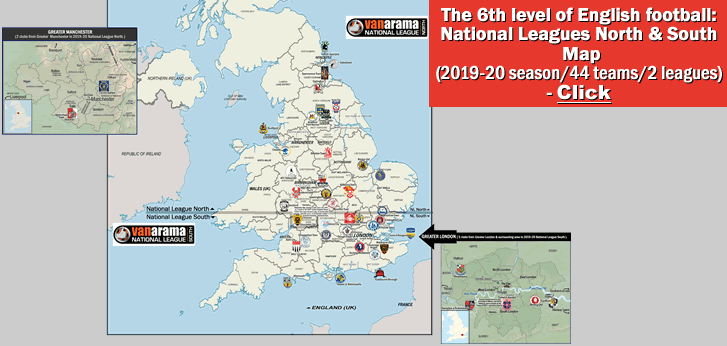
The 6th division in England: 2019-20 National League North & National League South (2 separate 22-team leagues, at the same level) – map, with 18/19-attendances-&-finishes chart
…
…
By Bill Turianski on 9 September 2019; twitter.com/billsportsmaps.
- 6th division England:
2019-20 National League North & National League South (2 separate 22-team leagues, at the same level)
The 6th level in English football is where the regionalised leagues begin. Above is the 5th division, the National League, which is the highest level of non-League football and the only non-League level that is nationalised. The 6th level has two leagues: the National League North and the National League South. Below that is the 7th level, which used to be comprised of 3 leagues, but since 2018-19 there are now 4 leagues in the 7th level. (The new league in the 7th level was the the result of splitting the Southern League into two leagues: the Southern League – Central and the Southern League – South.)
A brief history of the 5th and 6th tiers in England…
1979-80: 5th level of English football instituted with the Alliance Premier League: the 5th level and the highest level of non-League football in England (and Wales).
1986-87: Promotion/Relegation established between the 5th level and the 4th Division of the Football League.
2004-05: The 6th level of football instituted, with the creation of 2 regional leagues below the 5th level: the Conference North & the Conference South (22 teams in each league).
2015-16: names of the three leagues changed to…5th level: National League / 6th level: National League North & National League South.
…
A brief re-cap of the 2018-19 6th level…
Promoted, automatically, to the 5th division (the National League)…
-2018-19 National League North: Stockport County (who won the NL-N by 1 point over Chorley).
-2018-19 National League South: Torquay United (who won the NL-S by 10 points over Woking).
Promoted, via the play-offs, to the 5th division (the National League)…
-2018-19 National League North: Chorley (beating Spennymoor Town, in the final, 1-1/aet/4-3 on penalties).
-2018-19 National League South: Woking (beating Welling Utd, in the final, 1-0).
Clubs promoted to the 6th level…
-Clubs promoted to National League North:
Promoted from Northern Premier League Premier Division: Farsley Celtic.
Promoted from Southern League Premier Division Central: Kettering Town, King’s Lynn Town.
-Clubs promoted to National League South:
Promoted from Isthmian League Premier Division: Dorking Wanderers, Tonbridge Angels.
Promoted from Southern League Premier Division South: Weymouth.
Clubs relegated out of the 5th division into the 6th level…
Braintree Town, Gateshead, Havant & Waterlooville, Maidstone United.
Clubs relegated out of the 6th level into the 7th level…
-2018-19 National League North: Ashton Utd, FC United of Manchester, Nuneaton Borough.
-2018-19 National League South: Truro City, East Thurrock Utd, Weston super-Mare.
…
- The 6th division’s two 1st-place teams, as of 9 September 2019 (with 9-or-10 games played)…
-2019-20 National League North… Link for league table…soccerway.com/[2019-20 National League North].
1st place: the just-promoted King’s Lynn Town.
King’s Lynn Town are from King’s Lynn, Norfolk (population 44,000), on Norfolk’s north coast, within the marshy lowland estuary called the Wash. The town of King’s Lynn is situated, by road, about 32 miles (52 km) west of Norwich. King’s Lynn Town wear Pale-Blue-jerseys-with-Yellow pants, and have the nickname of the Linnets. The club plays at the Walks Stadium, as did their predecessor-club. The club was established in 2010, as the Phoenix-club of King’s Lynn FC (1879-2009).
For their debut season 10 years ago, King’s Lynn Town were placed in the 9th level, in the United Counties League; they then won 2 promotions in 3 seasons…They won promotion to the 8th level in their second season (2011-12). And then they won promotion to the Northern Premier the following season of 2011-12. But then King’s Lynn Town languished for 7 seasons in the 7th tier. Midway through that spell, the club was transferred to the Southern League (in 2015-16). When the 7th level expanded from 3 to 4 leagues in 2017-18, King’s Lynn Town were placed in the Southern Premier-Central. The club finally won promotion to the 6th tier as a super-play-offs winner in 2019, beating Stratford Town and Alvechurch, en route to a 3-2 victory over Warrrington Town in the 7th-level’s super play-off final. So now King’s Lynn Town have made it to the 6th division, which was the highest point that the original club had achieved (back in 2008-09). The new club, who drew 712 per game last season, are now averaging 1.1 K per game, which is just about exactly the same as what the old club was drawing, right before they imploded eleven years ago. {Attendance figures for non-League from over 10 years ago are hard to find, but my first map on this subject, from way back in October 2008, shows that the late lamented King’s Lynn FC were the 24th-best-drawing non-League club as of October 2008…click on the following to see that map…http://billsportsmaps.com/?p=1666.}
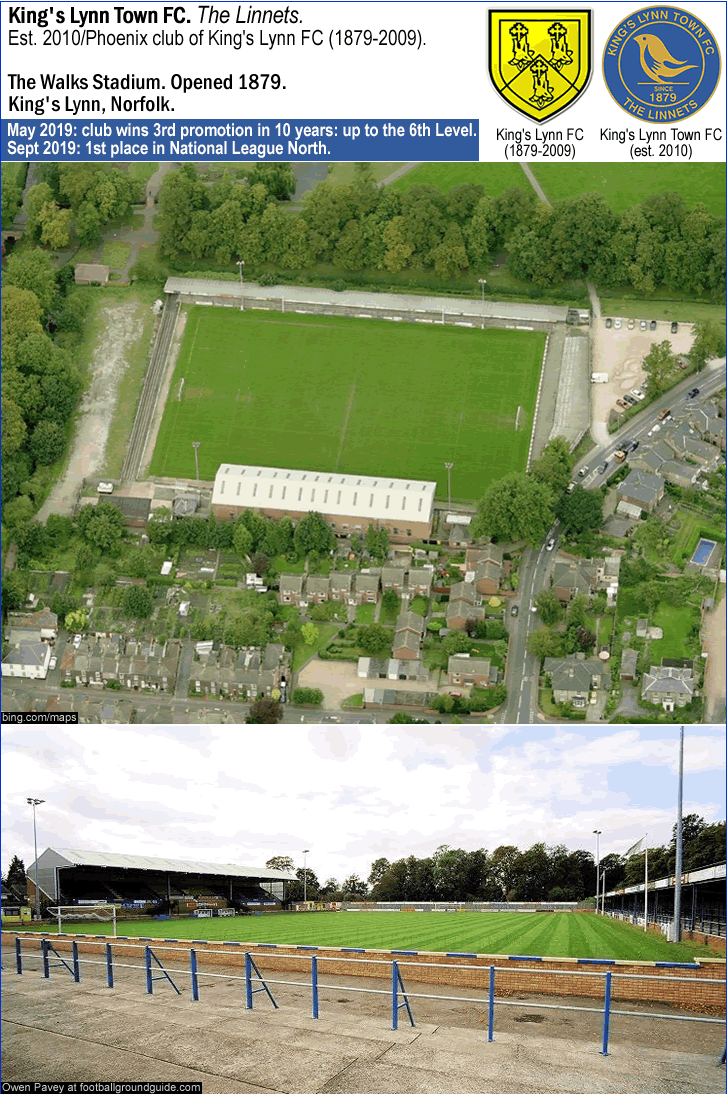
Photo and Image credits above – Aerial shot [satellite image], screenshot from bing.com/maps. Main Stand, photo by Owen Pavey at footballgroundguide.com/king-lynn-town-the-walks.
…
2019-20 National League South… Link for league table…soccerway.com/[2019-20 National League South].
1st place: Wealdstone.
Wealdstone FC are from Ruislip, which is in NW Greater London (and was formerly situated in Middlesex). Wealdstone wear Royal-Blue-with-White, and have two nicknames: the Stones, and the Royals. Wealdstone were a founding member of the the 5th division in 1979-80 [as part of the first season of the Alliance Premier League, which was the precursor to the Conference National and then the National League]. The clubs’ greatest moment came in 1984-85, when Wealdstone not only won the Alliance Premier, but also won the FA Trophy: thus becoming the first club to ever win the non-League Double (see photos and caption below). The only problem was that Wealdstone were a couple years ahead of their time, because at that point, there was no automatic promotion – yet – between the 5th division and the Football League. That was instituted a mere two years later, in 1986-87. So Wealdstone, failing to grab the attention of the old-boys-club which kept vast amounts of worthy, title-winning non-League clubs out of the Football League for decades, remained in non-League football. (In the 29 seasons from when the Football League Fourth Division was formed, in 1958-59, to 1985-86 [which was the last season in the Football League with no automatic relegation out of the League], only three clubs got voted out of the Football League.)
And then, three years later, Wealdstone got relegated out of the 5th division, in 1987-88. Then it got worse: financial problems, in 1991, saw them lose their Lower Mead ground. Wealdstone were homeless for 17 years, first renting at Watford’s Vicarage Road, then in 1993 Wealdstone were renting at Yeading FC’s ground. Then in 1995 Wealdstone were renting at Edgeware FC’s ground. Then in 2005, Wealdstone were renting at Northwood FC’s ground. Finally, in 2008-09, Wealdstone acquired Ruislip Sports and Social club, and moved into Ruislip Manor’s Grosvenor Vale ground. Five seasons later, in 2013-14, Wealdstone won the Isthmian Premier, by 11 points over Kingstonian. Since being in the 6th tier (Conference South/National League-South), that is to say, since 2014-15, Wealdstone have finished in 12th, then in 11th, then in 8th, then in 13th, and last season, in 7th. Last season Wealdstone drew 882 per game; this season they are drawing 901 per game as of early September 2019. And if they keep up their solid form, Wealdstone will certainly be drawing well over one thousand per game, come April 2020.
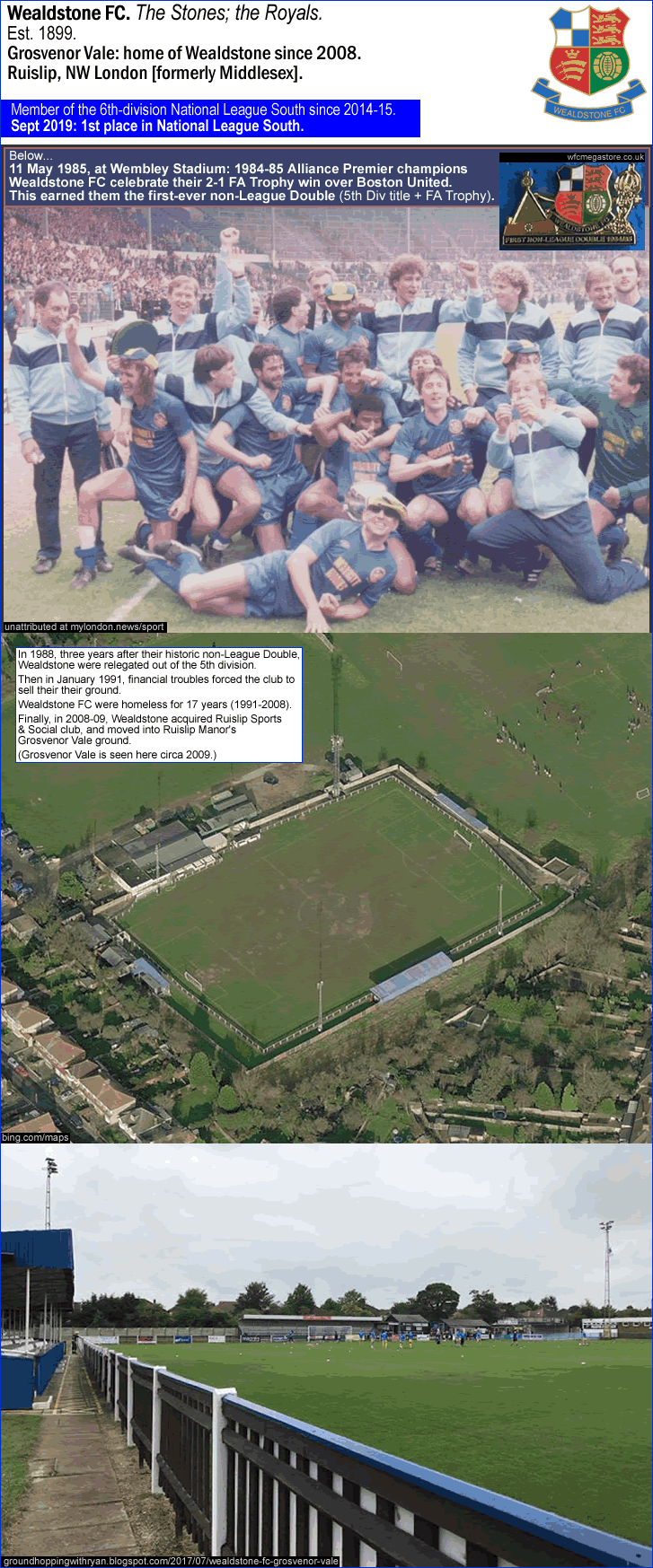
Photo and Image credits above – Photo from the 11th of May 1985: 1984-85 Alliance Premier champions Wealdstone celebrating their 1985 FA Trophy win over Boston United (2-1), earning them them first ever non-League Double (5th division title & cup-win): photo unattributed at mylondon.news/sport. Photo of enamel pin of Wealdstone’s historic non-League Double of 1985: from wfcmegastore.co.uk. Aerial shot of Grosvenor Vale: screenshot of satellite image from bing.com/maps. Interior shot of Grosvenor Vale: photo by Ryan at groundhoppingwithryan.blogspot.com/2017/07/wealdstone-fc-grosvenor-vale.
___
Thanks to all at the links below…
-Thanks to the contributors at National League (English football) (en.wikipedia.org).
-Thanks to Nilfanion at Wikipedia…Blank map of UK historic counties, by Nilfanion (using UK Ordnance Survey data), at File:United Kingdom police areas map.svg (commons.wikimedia.org). Blank relief map of Greater London, by Nilfanion (using UK Ordnance Survey data), at File:Greater London UK relief location map.jpg. Blank relief map of Greater Manchester, by Nilfanion (using Ordnance Survey data), at File:Greater Manchester UK relief location map.jpg (commons.wikimedia.org).
Photos/Images of kit badges…
[Curzon Ashton 17/18 jersey badge], twitter.com/[@curzonashton].
[Chester 17/18 jersey badge], chesterfc.com/all-ticket.
[Spennymoor 14/15 jersey badge], oldfootballshirts.com.
[Billericay], billericaytownfc.co.uk/product/2017-18-home-shirt-2.
[Chippenham], pitchero.com/clubs/chippenhamtown.
[Dulwich Hamlet], pitchero.com/clubs/dulwichhamlet/.
[Eastbourne (script on badge)], ebfc.co.uk/news.
-Thanks to the Non-League Matters site for non-League attendance figures, nonleaguematters.co.uk.


